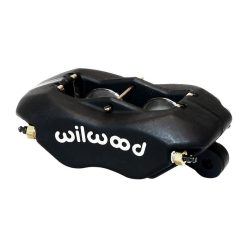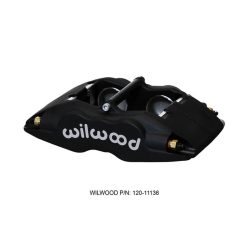The Racing brake calipers category focuses on high-performance, multi-piston brake calipers designed for motorsport and serious fast-road use. The range currently features Wilwood calipers and is planned to expand with AP Racing, Brembo and other leading motorsport brands. These racing calipers offer increased clamping force, better heat management and more consistent pedal feel, making them ideal for big brake kits on track, drift and time-attack builds.
Net price: 254 €
Net price: 307 €
Role and Key Benefits of Racing Brake Calipers
Racing brake calipers are the core of any high-performance braking system: they convert hydraulic pressure at the pedal into clamping force at the pads and discs. A well-chosen multi-piston caliper not only increases outright stopping power but also improves pedal consistency, modulation and confidence over long stints. The calipers offered in this category are engineered for motorsport scenarios, matched to larger disc diameters and aggressive pad compounds to minimise fade and disc distortion, even when disc temperatures soar.
The current line-up is centred around Wilwood models (such as Forged Dynalite and Superlite Internal), and the category is intended to grow with AP Racing, Brembo and other renowned brands over time. What these products have in common is a rigid body, optimised piston area and efficient cooling. The goal is simple: consistent, repeatable braking so that the car stops at the same point and with the same pedal travel at the end of the session as it does at the start, even on heavy cars with sticky tyres and big aero.
Technical Basics
Most racing calipers are fixed, multi-piston units. Unlike sliding calipers that move on guide pins, a fixed caliper is bolted solidly to the upright and uses pistons on both sides of the disc to clamp the pads. Multiple pistons with staggered diameters are used to generate an even pressure distribution across the pad surface, reducing hot spots, tapered wear and disc cracking. Staggered piston sizes (for example 30–36–38 mm) help prevent pad “leading edge” bite and fine-tune pedal response.
Material choice is critical. High-end monoblock calipers are machined from a single billet of aluminium for maximum stiffness and low weight, while more cost-effective two-piece calipers use bolted halves. Stiffness matters because caliper flex translates directly into extra pedal travel and a vague feeling underfoot; the stiffer the body, the more of your leg effort goes into clamping the pads instead of opening the caliper. Many racing calipers also use stainless or titanium pistons and heat shields to limit heat transfer into the fluid and seals.
Thermal management is another key design driver. Larger, ventilated or even two-piece floating discs increase heat capacity, but the caliper must also be designed to cope with high temperatures. Features such as internal fluid galleries positioned away from the disc, insulating piston inserts and pad backing shims help keep brake fluid temperatures under control. This reduces the risk of boiling the fluid and experiencing vapour lock or a sinking pedal during extended track sessions.
Selection Criteria
Choosing the right racing brake caliper starts with a clear understanding of the vehicle’s weight, power and intended use. A lightweight 220 hp hot hatch on semi-slicks has very different requirements to a 1400 kg time-attack car on full slicks or a drift machine that spends much of its life sideways. Piston area must be matched to the master cylinder size so that pedal travel and effort fall into a usable range: too much piston area gives a long, soft pedal; too little results in a very firm pedal that is hard to modulate.
Disc diameter and thickness are equally important. A given caliper is designed for a specific disc thickness window (for example 28–32 mm) and pad radial height. Fitting a caliper to discs that are too thin can cause the pistons to over-extend, reducing support for the sealing area and risking leaks or seal rollback. Always consult the manufacturer’s data to confirm disc diameter, thickness and pad dimensions, and avoid mixing components blindly just because they physically bolt together.
Wheel size and design are also critical constraints. Large 4- and 6-piston calipers often require at least 17–18" wheels, and spoke shape matters as much as diameter. It is common for a caliper to clear the inner barrel but foul the spokes. Whenever possible, use the supplier’s brake template to check wheel clearance, or rely on the experience of a workshop that has already built similar combinations. Planning wheels, brakes and suspension as a complete package saves a lot of frustration later.
Finally, think about pad and disc choices. Many racing calipers are designed around motorsport friction materials that only deliver their best performance once hot; these may be noisy and less effective at low temperatures on the road. If the car is driven to and from the track, a “fast road/track” pad compound might be a better compromise. In all cases, the caliper, pad and disc must form a coherent system that suits your driving style and event type.
Installation & Maintenance
Installing racing brake calipers is safety critical and should ideally be carried out by an experienced technician or motorsport shop. Caliper mounting bolts must be torqued to the manufacturer’s specification using a calibrated torque wrench, with appropriate threadlocker where required. Correct hub–disc–caliper alignment is essential: disc runout should be measured and kept within limits, and pad clearance must be checked to ensure the pads move freely without binding or rattling excessively.
After installation, a proper bed-in procedure is essential. Bedding in establishes a uniform transfer layer between pad and disc, stabilising friction and reducing the likelihood of vibration or surface cracking. Skipping this step often leads to inconsistent bite, judder and premature disc issues. Every new caliper/pad/disc combination should be bedded in using a series of progressively harder stops, followed by a cool-down phase.
Ongoing maintenance includes regular inspection of seals, dust boots, pad hardware and mounting bolts. For track-driven cars, it is wise to check calipers after each event for discolouration, leaks, uneven pad wear or cracked paint and to verify bolt torque on mounts and, where applicable, bell-to-rotor fasteners. High-performance calipers should always be used with fresh, high-quality DOT 4 racing brake fluid, changed at appropriate intervals to guard against boiling and loss of performance.
FAQ
How are racing brake calipers different from stock calipers?
Racing calipers typically use multiple pistons, stiffer bodies, larger pad areas and better cooling than OE units. This delivers greater stopping power, more consistent performance and improved pedal feel, though it comes with higher cost and usually more frequent service requirements.
Do I need racing brake calipers for a road-only car?
If your car is used only for normal road driving, a quality pad and disc upgrade is often sufficient. However, if you attend track days, drive hard on mountain roads or have significantly increased engine power, racing calipers can provide an important safety margin and more stable braking under repeated heavy use.
Can I run racing calipers with the stock master cylinder?
Sometimes yes, but the total piston area must be compatible with the master cylinder. If the pedal becomes excessively long or very hard to press after an upgrade, you may need to change master cylinder size or move to a pedal box. It is wise to calculate piston areas and, if in doubt, consult a specialist before purchasing.
Do racing calipers require special brake fluid?
It is strongly recommended to use a high-quality DOT 4 racing brake fluid with racing calipers, as the higher disc and caliper temperatures can easily exceed the capabilities of basic OE fluid. Racing fluids offer much higher dry and wet boiling points, reducing the risk of fade and vapour lock.
Are racing calipers road legal?
Legality depends on local regulations and whether a particular big brake kit has any form of type approval or certification. Some kits are engineered and documented specifically for road use, while others are intended strictly for off-road or competition. Always check your local rules and choose components accordingly.



